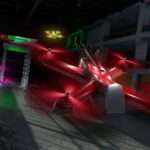
Step-by-Step Guide to Building an FPV Racing Drone:
Engine and Propeller Selection, and Parts Recommendations for Low Budget, Midrange and Professional Builds
- Soldering iron and solder
- Allen key
- Side cutter
Step 1:
Choose the frame – The frame is the foundation of your drone and the first part you should select. Look for a frame that is durable, lightweight, and easy to repair. For a low budget option, you can consider the HGLRC Wind5 5 Inch Hybrid Frame. For a mid-range option, the iFlight XL7 V4 True X Frame is a good choice. And for a professional option, the TBS Source One V3 Frame is a popular choice.
Step 2:
Select the flight controller – The flight controller is the brain of your drone and it’s important to choose one that is compatible with your other components. For a low budget option, you can consider the Mamba F405 MK2 Flight Controller. For a mid-range option, the Holybro Kakute F7 Flight Controller is a good choice. And for a professional option, the T-Motor F7 HD Flight Controller is a top choice.
Step 3:
Choose the motors – The motors provide the power to your drone and you need to choose ones that are reliable and efficient. For a low budget option, the iFlight XING-E 2207 1800KV Motors are a good choice. For a mid-range option, the T-Motor F60 Pro III 2207 2500KV Motors are a popular choice. And for a professional option, the Brotherhobby Avenger V3 2207.5 Motors are a high-performance choice.
Step 4:
Select the ESCs – The ESCs control the speed of the motors and it’s important to choose ones that can handle the power demands of your motors. For a low budget option, the Racerstar TattooF4S 30A ESCs are a good choice. For a mid-range option, the Holybro Tekko32 35A ESCs are a popular choice. And for a professional option, the T-Motor Pacer 60A ESCs are a high-performance choice.
Step 5:
Choose the propellers – The propellers affect the performance of your drone and you should choose ones that are balanced and efficient. For a low budget option, the Gemfan Flash 5152 Propellers are a good choice. For a mid-range option, the HQProp DP7X3.5X3V1S Propellers are a popular choice. And for a professional option, the T-Motor T5143S Propellers are a high-performance choice.
Step 6:
Select the camera – The camera is what allows you to see from the perspective of your drone and it’s important to choose one that is reliable and provides good quality video. For a low budget option, the Caddx Ratel FPV Camera is a good choice. For a mid-range option, the Foxeer Predator V4 FPV Camera is a popular choice. And for a professional option, the DJI FPV Camera is a high-performance choice.
Step 7:
Choose the video transmitter – The video transmitter is what sends the video signal from your drone to your goggles or screen and it’s important to choose one that is reliable and provides a clear signal. For a low budget option, the Eachine TX805 VTX is a good choice. For a mid-range option, the Rush Tank Ultimate Plus VTX is a popular choice. And for a professional option, the TBS Unify Pro32 HV VTX is a high-performance choice.
Step 8:
Select the battery – The battery provides the power to your drone and you need to choose one that can handle the power demands of your components. For a low budget option, the Tattu
5 Assemble the drone frame: Once you have all the parts, you can start assembling the drone. First, mount the flight controller onto the frame using screws or double-sided tape. Next, attach the ESCs to the arms of the frame, making sure to follow the correct motor-to-ESC wiring diagram. Then, attach the motors to the ESCs using the motor screws. Finally, mount the FPV camera and video transmitter onto the frame.
6 Configure the drone: After assembling the drone, you need to configure it. Connect the flight controller to a computer using a USB cable and install the Betaflight software. Then, use the software to configure the flight controller and set up the PID tuning. You can also configure the OSD (on-screen display) to show important information such as battery voltage and flight time.
Test and fly: Before flying the drone, it’s important to test it. Check that all the motors are spinning in the correct direction and that the drone is stable when hovering. You can also test the video transmission to ensure that the camera and video transmitter are working correctly. Once you’re confident that everything is working, you can take the drone out for a test flight.
Recommended Parts for Low Budget Builds:
• Frame: Eachine Wizard X220S
• Flight Controller: Matek F405-CTR
• Motors: Emax RS2205 2300KV
• ESCs: Emax Bullet 30A
• Propellers: Gemfan 5040
• FPV Camera: Caddx Turbo Micro F2
• Video Transmitter: Eachine TX526
Recommended Parts for Mid-Range Builds:
• Frame: TBS Source One
• Flight Controller: Holybro Kakute F7
• Motors: T-Motor F40 Pro II 2400KV
• ESCs: T-Motor Velox 45A
• Propellers: HQProp 5×4.3×3
• FPV Camera: RunCam Swift 2
• Video Transmitter: TBS Unify Pro HV
Recommended Parts for Professional Builds:
• Frame: Armattan Chameleon TI
• Flight Controller: Bardwell F4
• Motors: T-Motor F60 Pro IV 1750KV
• ESCs: Hobbywing XRotor Pro 50A
• Propellers: Azure Power 5140
• FPV Camera: Foxeer Predator Micro V4
• Video Transmitter: TBS Unify Pro HV
Keep in mind that there are many different parts available on the market, and the parts listed above are just recommendations. It’s important to research and choose the parts that best fit your specific needs and budget.








